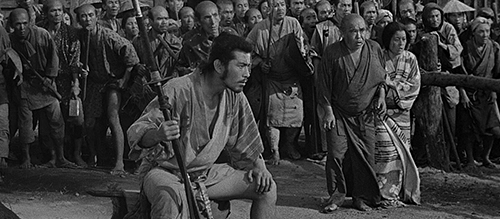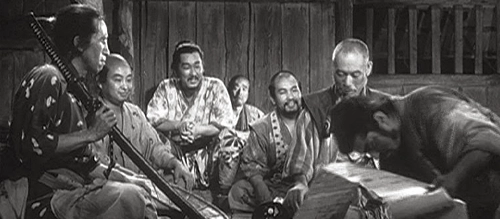‘Seven Samurai’ at 70 – Review

Seven Samurai (1954)
Director: Akira Kurosawa
Screenwriters: Akira Kurosawa, Shinobu Hashimoto, Hideo Oguni
Starring: Toshiro Mifune, Seiji Miyaguchi, Isao Kimura, Daisuke Katō, Yoshio Inaba, Takashi Shimura, Keiko Tsushima, Kamatari Fujiwara
It is true that sometimes there are more things to a film than meets the eye. We try to loop our fingers through it, we swallow its visuals whole. We label it by genre, critique it by checkboxes. But sometimes, when we least search for it, a film can sneak up on you. A sliver of something escapes from an unnoticed crack and it becomes more than a category; it transcends the conventions of a war film, of a rom-com, of a horror flick. Real cinema is the film that speaks to something that you didn’t even know existed in you. It does this quite simply, quite magically: because you weren’t looking for it.
There’s a reason why Seven Samurai is regarded as one of the most ‘remade, reworked and referenced’ films of all time. It was a meticulously constructed phenomenon. Production included a six-week writing process, a complete set construction and a 148-day shoot. Kurosawa believed that a director was nothing without a rich script, evocative editing, and a soundtrack to match. It was down to his creative dedication that Seven Samurai become known as ‘Akira Kurosawa’s masterpiece.’
Martin Scorsese once said, ‘cinema is a matter of what’s in the frame and what’s out,’ and Seven Samurai certainly fits that criteria. Kurosawa’s epic had DNA that seeped into generations of filmmaking; he created an experience so mightily human it seeps from the edges of your screen.
Seven Samurai settles itself in the Sengoku period of feudal Japan, more specifically in 1586. The film’s central village is attacked by bandits, leaving its inhabitants fearful and morose. Thus, they decide to seek out samurai to defend them. After approaching veteran samurai, Kanbê Shimada (played by Takashi Shimura), a defence is slowly planned out. He is soon joined by six other samurai, which include the youthful protégé Katushiro (Isao Kimura) and drunkenly volatile Kikushiyo (Toshiro Mifune).
Writing for The New York Daily News, Wanda Hale wrote that Kurosawa had ‘exceeded himself’ with his ‘action picture.’ She also praised his ‘deep perception of human nature.’ This duality is why Seven Samurai is a stellar feat of cinema.
Kurosawa’s 1954 epic sits like a book of fables in your hands. You can turn its pages and hear the roar of fictitious gods, the clang of slender swords. Seven Samurai also holds onto your soul like an infant; instead of bellowing, it coos. Misty-eyed, you gaze upon the villagers’ grief, the suffering of its women and the traumas of the samurai’s past. From thick mud to flowering field, every range of the human experience is brushed upon.
The film’s score and atmosphere are amiable companions, embracing scenes with an unmistakable honesty. Dust and tears shroud the opening sequences, establishing the film’s gritty air. The first time we see the villagers, their grieving bodies heave against one another. Scenes taking place in their homes feel closeted and morose, similar to the set of A Streetcar Named Desire (1951). Composer Fumio Hamasaka matches this, using a deep male chorus to tower over the scenery.
This atmosphere does not remain pervasive, however. The village is a mirror; it reflects the changing mindsets of its weary villagers. When the samurai enter, breath and space seem to flow through every room. The soundscape becomes richer, brassier, showcasing the hope-instilling honour of the samurai. The foreboding choruses become airier, with Hamasaka infusing traditional Japanese sounds into the local village life.

It’s clear to see that Kurosawa’s vision dawned on him, like a blessing in prayer; watching it unfold ignites a spark inside your chest. He used three separate cameras in filming, their directions orientated via diagram. Using a telephoto lens, he would stack the front, middle and back of his scenes with character reactions. In their stillness, we are given multiple perspectives. In a similar fashion, Kurosawa often pins his focus to the middle of our screens. Using this technique, characters are placed under trial and called into question by the filmmaker.
This sense of control and order is reluctantly dashed by the final act. As conflict breaks out, scenes are wrought by constant movement. The camera work becomes fluid, with its lack of cross-cutting later inspiring films such as The Lord of the Rings: The Two Towers (2002). This heightens the conflict’s consequences, making us soak up the collapsing bodies and streaming arrows. Once called ‘the world’s greatest editor,’ Kurosawa allows scenes to remain brief, so as not to elongate. Although some transitions remain choppy, his decisions allow for maximum plot engagement.
Where Seven Samurai truly thrives is in its moral edge; every corner yields a jewelled message. The hierarchy of the feudal Japanese village is the most obvious; the farmers, socially-dwarfed by the samurai, must provide for them accordingly. The samurai themselves make for an interesting moral debate. As the film progresses, few differences can be identified between the bandits and the samurai.
With the samurai as the life force of the film, a far more prominent message is revealed: what does it mean to be honourable? Much like the gentlemen of Dickens’ “Great Expectations”, samurai are meant to exemplify virtuous qualities. But, as Roger Ebert stated, ‘like characters in a Greek tragedy,’ they fall prey to their own fatal flaw.
Takashi Shimura’s performance as Kanbê Shimada is a calm storm. He is the calculating leader, plagued by the wisdom of war. Kanbê’s past has made him jaded, his soul seemingly decades older. In his first scene, he shaves his hair off, signalling his reluctant re-entry into combat. However, his honour lies in his ability to move forward. Much like a pebble, he allows the rivers of time to move him. Kanbê brings the samurai together, conducts the village’s lessons and the structures of their battles. Shimura is able to bring the right sense of authority to the role, allowing us to fully trust the film’s narrative.
Isao Shimura plays Katsushirō, the disciple. As Kanbē’s protégé, he represents the naivety of youthful ambition. Isao plays him as quiet, studious, and curious. He brings out the film’s softer side with a blossoming romance when Katsushriō meets Shino (played by Keiko Tsushima). The two begin a tender, childlike romance, in the petals of a flower field. This is cleverly introduced by Kurosawa, to commemorate the beauty of youth.
Katushirō’s level of honour is, however, called into question. After spending the night with Shino, she is humiliated by her father. After being congratulated by the samurai, Katushirō is left mute by his actions. Throughout the final scenes, he is glued to our screen’s centre; nailed to the cross of his actions, he now represents the disruption of honour.
The film’s final samurai, Kikuchiyo, is our loose-cannon. The role was played by the legendary Toshiro Mifune, who starred in 16 other Kurosawa pictures. Famed for his aggressively erratic energy, he studied wild tigers to prepare for the role. And, as Kikuchiyo, he dominates throughout the film. He demands our focus, and from his roaring spit to his near-constant movement, he gains it.
What makes Mifune’s performance show-stopping is his use of emotional levels. Whilst Mifune provides his signature hostile nature, he is also the film’s comic relief. Often seen chasing children or hauling villagers back to a brawl, Kikuchiyo becomes palatable and charming. It is, however, his vulnerable side that makes this film an empathetic experience. Kikuchiyo, we learn, is a broken child of man; his honour lies in his ability to question the unquestionable. In one striking moment, he monologues straight to camera. Mifune’s intensity is so human that it shocks life into you.
Seven Samurai murmurs of a realm where gods can touch men, can give them the power to slice and to claim. Seven Samurai speaks of a place where even the harshest of winters can thaw to give way for a fruitful harvest. But, most importantly, Seven Samurai shouts of a feeling: it shouts of a feeling of humanity. From the farmer’s grains of rice, to Kanbē’s shaved head, to the bandit’s charging horse, to the bloom of a flower – they are all threaded together by the reality of the human experience. So, if you decide to trek the mountains of this 1954 epic, be on your guard; Kurosawa has made sure that you will leave with more than just a sword and armour.
Score: 24/24
Recommended for you: Where to Start with Akira Kurosawa
Written by Bella Madge
You can support Bella in the following places:
Substack: BellaWatchesFilms
Instagram: @bellawatchesfilms
TikTok: @bellawatchesfilms
Picturehouse Fresh Takes: Name Me Lawand Review

